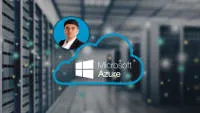
Learning Microsoft Azure Step by Step Part 1 
This comprehensive Microsoft Azure course provides an in-depth look at the fundamentals of the platform, making it an ideal starting point for those looking to learn the basics. ▼
ADVERTISEMENT
Course Feature
![]() Cost:
Cost:
Free
![]() Provider:
Provider:
Udemy
![]() Certificate:
Certificate:
No Information
![]() Language:
Language:
English
Course Overview
❗The content presented here is sourced directly from Udemy platform. For comprehensive course details, including enrollment information, simply click on the 'Go to class' link on our website.
Updated in [April 29th, 2023]
This course, Learning Microsoft Azure Step by Step Part 1, provides an introduction to Microsoft Azure Cloud. It is designed to help learners become familiar with the platform and its features. The course covers topics such as creating and managing virtual machines, storage accounts, and virtual networks. Additionally, learners will learn how to deploy and manage web applications, and how to use Azure services such as Azure Active Directory and Azure Monitor. By the end of the course, learners will have a good understanding of the basics of Microsoft Azure Cloud and be able to use it to create and manage cloud-based applications.
[Applications]
After completing this course, learners can apply their knowledge of Microsoft Azure Cloud to develop and deploy applications on the cloud. They can also use the cloud to store and manage data, create virtual machines, and use the various services available on the cloud. Additionally, learners can use the cloud to create and manage web applications, mobile applications, and IoT applications. Furthermore, they can use the cloud to create and manage databases, networks, and security. Finally, learners can use the cloud to create and manage DevOps pipelines.
[Career Paths]
1. Cloud Solutions Architect: Cloud Solutions Architects are responsible for designing, developing, and managing cloud-based solutions. They must have a deep understanding of cloud computing technologies, such as Microsoft Azure, and be able to develop and implement cloud-based solutions that meet the needs of their organization. The demand for Cloud Solutions Architects is growing rapidly, as more and more organizations are turning to cloud-based solutions to reduce costs and increase efficiency.
2. Cloud Developer: Cloud Developers are responsible for developing and maintaining cloud-based applications. They must have a deep understanding of cloud computing technologies, such as Microsoft Azure, and be able to develop and maintain cloud-based applications that meet the needs of their organization. The demand for Cloud Developers is growing rapidly, as more and more organizations are turning to cloud-based solutions to reduce costs and increase efficiency.
3. Cloud Security Engineer: Cloud Security Engineers are responsible for designing, developing, and managing cloud-based security solutions. They must have a deep understanding of cloud computing technologies, such as Microsoft Azure, and be able to develop and implement cloud-based security solutions that meet the needs of their organization. The demand for Cloud Security Engineers is growing rapidly, as more and more organizations are turning to cloud-based solutions to reduce costs and increase efficiency.
4. Cloud Database Administrator: Cloud Database Administrators are responsible for designing, developing, and managing cloud-based databases. They must have a deep understanding of cloud computing technologies, such as Microsoft Azure, and be able to develop and maintain cloud-based databases that meet the needs of their organization. The demand for Cloud Database Administrators is growing rapidly, as more and more organizations are turning to cloud-based solutions to reduce costs and increase efficiency.
[Education Paths]
1. Bachelor of Science in Computer Science: This degree path provides students with a comprehensive understanding of computer science, including programming, software engineering, and computer systems. Students will learn the fundamentals of computer science, as well as the latest technologies and trends in the field. This degree path is ideal for those who want to pursue a career in software engineering, cloud computing, or other related fields.
2. Master of Science in Cloud Computing: This degree path provides students with a deeper understanding of cloud computing, including the architecture, security, and management of cloud systems. Students will learn the fundamentals of cloud computing, as well as the latest technologies and trends in the field. This degree path is ideal for those who want to pursue a career in cloud computing, software engineering, or other related fields.
3. Bachelor of Science in Information Technology: This degree path provides students with a comprehensive understanding of information technology, including networking, security, and data management. Students will learn the fundamentals of information technology, as well as the latest technologies and trends in the field. This degree path is ideal for those who want to pursue a career in network engineering, cloud computing, or other related fields.
4. Master of Science in Artificial Intelligence: This degree path provides students with a deeper understanding of artificial intelligence, including machine learning, natural language processing, and robotics. Students will learn the fundamentals of artificial intelligence, as well as the latest technologies and trends in the field. This degree path is ideal for those who want to pursue a career in artificial intelligence, cloud computing, or other related fields.
Course Syllabus
Three Parts of Microsoft Azure Cloud
Understanding Data Centers and Regions
Creating SQL SERVER Database on Azure
Understanding SQL Geo Replication
Creating Windows Server Virtual Machine
Configuring Virtual Machine
Pros & Cons

Well-explained content for basic understanding

Easy to follow and great job in delivering the course

Detailed to an extent and guided in setting and knowing the basics

Volume of music at the start and end of modules needs to be reduced

Not enough time to cover each stage

Not enough clarity on certain arguments
Course Provider

Provider Udemy's Stats at AZClass
Discussion and Reviews
0.0 (Based on 0 reviews)
Explore Similar Online Courses

Get Started With Tableau

Creative Product Photography from Start to Finish

Python for Informatics: Exploring Information

Social Network Analysis

Introduction to Systematic Review and Meta-Analysis

The Analytics Edge

DCO042 - Python For Informatics

Causal Diagrams: Draw Your Assumptions Before Your Conclusions

Whole genome sequencing of bacterial genomes - tools and applications

Microsoft Azure Online Data Engineering Training

Cloud Developer using Microsoft Azure


Start your review of Learning Microsoft Azure Step by Step Part 1